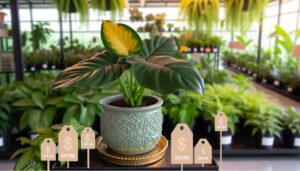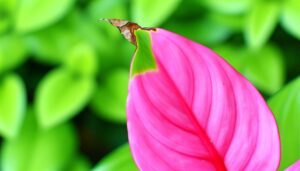Why Is My Pink Princess Philodendron Not Pink?
The absence of pink coloration in your Pink Princess Philodendron is often associated with inadequate light, as this plant requires bright, indirect light to maintain its variegation. Overwatering may lead to root rot, affecting foliage color.
Optimal humidity levels between 60-80% are vital for vibrant pigmentation. Nutrient deficiencies, especially in nitrogen, phosphorus, and potassium, can also impact leaf coloration.
Soil quality, including proper drainage and sufficient nutrient content, is fundamental. Furthermore, variegation may be less pronounced in younger plants or altered due to genetic instability.
Addressing these factors can greatly enhance your plant's aesthetics.
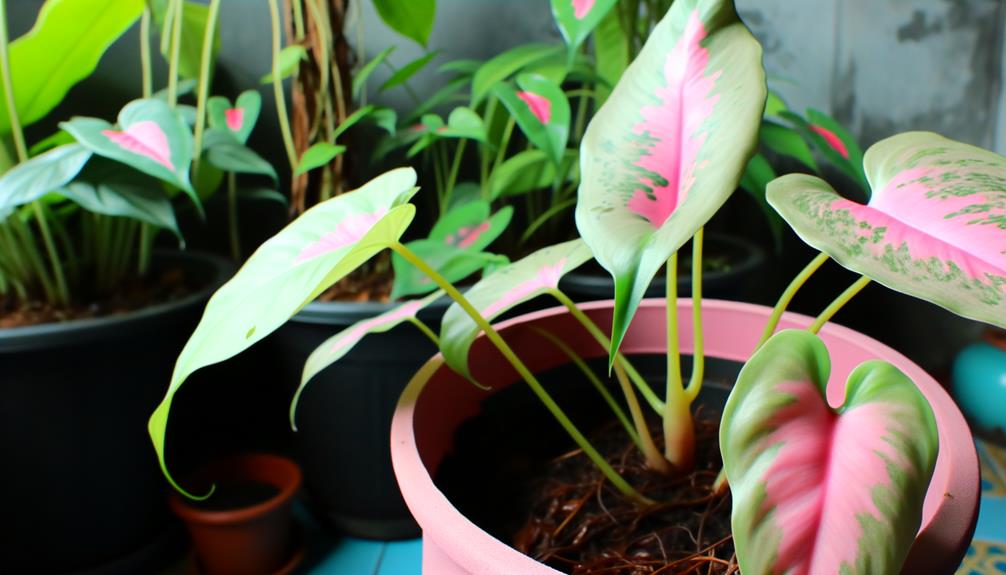
Key Takeaways
- Insufficient light can cause faded variegation, resulting in less pink coloration.
- Overwatering may lead to root rot, reducing the plant's ability to display vibrant pink hues.
- Genetic factors influence variegation; some plants naturally exhibit less pink.
- Inadequate nutrient levels, particularly nitrogen, affect leaf color and variegation.
- Younger plants often show less stable variegation compared to mature plants.
Insufficient Light
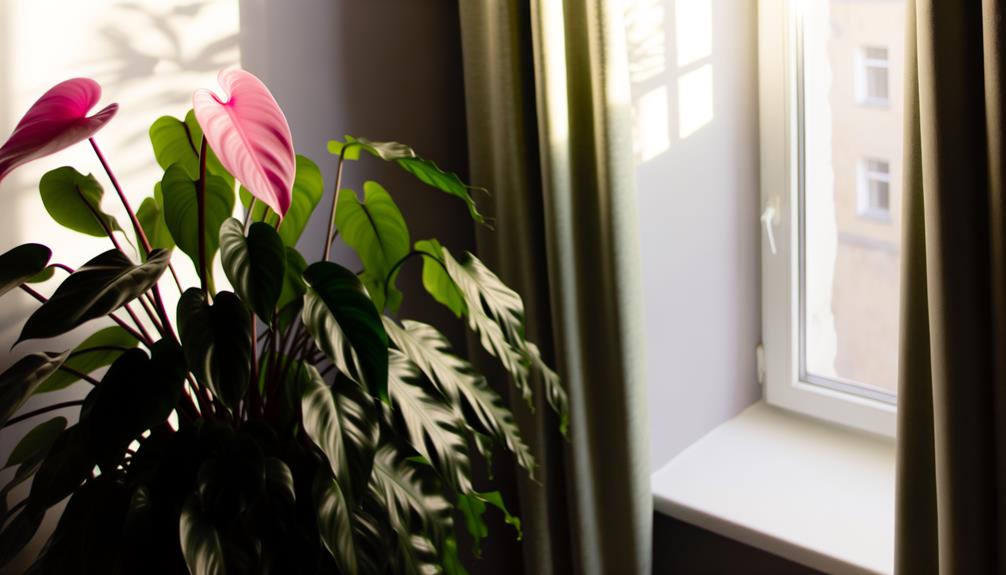
Inadequate light is a common issue that can significantly impact the growth and variegation of the Pink Princess Philodendron, often resulting in leggy stems and reduced vibrancy in its foliage. This plant flourishes under bright, indirect light, and subpar lighting conditions can lead to etiolation, characterized by elongated internodes and pale leaves.
To address this, position the plant near an east-facing window or use grow lights that offer a spectrum rich in blue and red wavelengths. Regularly rotate the plant to promote uniform light distribution, preventing asymmetrical growth.
Monitoring light levels with a light meter can provide quantitative insights, ensuring that the Pink Princess Philodendron receives the best light intensity, thereby fostering strong growth and preserving its distinctive pink variegation.
Overexposure to Light
Excessive light exposure can lead to leaf scorch and diminished variegation in the Pink Princess Philodendron, manifesting as bleached or brown patches on the foliage. This occurs because high-intensity light degrades chlorophyll and other pigments, reducing the plant's ability to photosynthesize effectively.
To mitigate such damage, it is vital to monitor environmental conditions closely.
- Light Intensity: Position the plant in indirect sunlight rather than direct, ensuring light levels are within ideal ranges.
- Leaf Symptoms: Observe for signs of stress, including discoloration or necrosis, as indicators of overexposure.
- Environmental Adjustments: Utilize sheer curtains or move the plant to a location with filtered light to prevent further harm.
Adhering to these guidelines can help maintain the vibrant coloration characteristic of this species.
Watering Issues
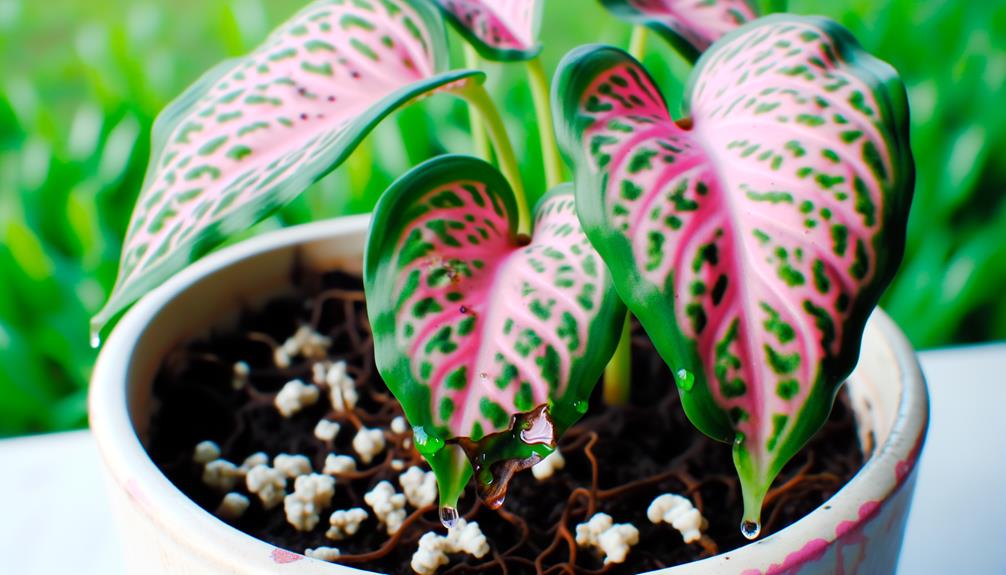
Watering issues in Pink Princess Philodendron mainly manifest through overwatering effects and an inconsistent watering schedule. Overwatering can lead to root rot, characterized by yellowing leaves, wilting, and a foul odor emanating from the soil.
Conversely, an erratic watering routine may induce stress, resulting in uneven growth and leaf browning, necessitating a consistent approach to hydration.
Overwatering Effects
Overwatering the Pink Princess Philodendron can lead to root rot, a condition characterized by blackened, mushy roots that impair the plant's ability to uptake essential nutrients and water. This pathological state not only stunts growth but also reduces the vibrancy of the variegated leaves, causing the pink coloration to fade.
To mitigate overwatering effects, consider the following:
- Drainage: Guarantee pots have adequate drainage holes to prevent water from stagnating.
- Soil Selection: Use a well-aerated, fast-draining soil mix to facilitate proper moisture levels.
- Watering Techniques: Check soil moisture before watering; only water when the top inch of soil feels dry.
Inconsistent Watering Schedule
An irregular watering schedule can cause physiological strain in the Pink Princess Philodendron, leading to unpredictable growth patterns and susceptibility to pests and diseases. This strain can result in decreased variegation, where the pink coloration fades. Consistency in watering ensures the plant's cellular functions operate at their best, supporting vibrant pigmentation.
Here is a table summarizing ideal watering practices:
| Watering Frequency | Soil Moisture Level | Observations |
|---|---|---|
| Weekly (during growth) | Evenly moist, not overly wet | Healthy, vibrant leaves |
| Bi-weekly (dormant phase) | Moderately dry between waterings | Stable variegation |
| Overwatering | Waterlogged | Root rot, yellow leaves |
Establishing a regular watering schedule minimizes physiological strain, thereby improving the plant's visual appeal.
Incorrect Humidity Levels
Maintaining the best humidity range, typically between 60-80%, is vital for the health of a Pink Princess Philodendron.
Regular monitoring of ambient humidity levels using a hygrometer can help identify discrepancies that could lead to issues such as leaf browning or stunted growth.
Practical methods to increase humidity include using a humidifier, placing the plant on a pebble tray with water, or grouping it with other plants to create a microenvironment.
Ideal Humidity Range
Achieving the best humidity range, usually between 60% and 80%, is crucial for the Pink Princess Philodendron to thrive and avoid issues related to incorrect humidity levels. Inadequate humidity can result in drying of leaf edges and decreased variegation, while excessive humidity promotes fungal growth and root rot.
To maintain the ideal environment, consider these practical tips:
- Grouping Plants Together: Boosts local humidity through collective transpiration.
- Using a Humidifier: Maintains consistent humidity levels, especially in dry climates.
- Misting Leaves: Offers immediate, though temporary, humidity boost.
Monitoring Humidity Levels
To achieve ideal growth conditions for the Pink Princess Philodendron, accurate and consistent monitoring of humidity levels is essential. Best humidity levels for this tropical plant range between 60% and 80%.
Utilizing a hygrometer can provide precise measurements, ensuring that the ambient humidity remains within this range. Inadequate humidity can lead to leaf browning and reduced variegation, thereby diminishing the characteristic pink hues that make this plant desirable.
Regularly inspect the hygrometer readings and adjust environmental conditions as necessary. Additionally, observe the plant for signs of humidity stress, such as curled or crispy leaf edges.
Consistent monitoring facilitates the maintenance of an environment conducive to the Pink Princess Philodendron's vibrant growth and variegation.
Increasing Humidity Effectively
Elevating humidity levels for the Pink Princess Philodendron can be effectively achieved through the use of humidifiers, pebble trays, or misting techniques. Utilizing these methods can counteract the detrimental effects of low humidity, which often leads to reduced variegation and compromised plant health.
Humidifiers: Positioning a humidifier near the plant guarantees a consistent moisture level in the air, promoting ideal growth.
Pebble Trays: Placing the plant on a tray filled with water and pebbles increases ambient humidity through evaporation, a cost-effective and efficient method.
Misting Techniques: Regularly misting the foliage with distilled water can provide immediate, albeit temporary, humidity boosts.
Attention to these humidity-augmenting strategies will enhance the plant's vibrant pink coloration and overall strength.
Nutrient Deficiencies
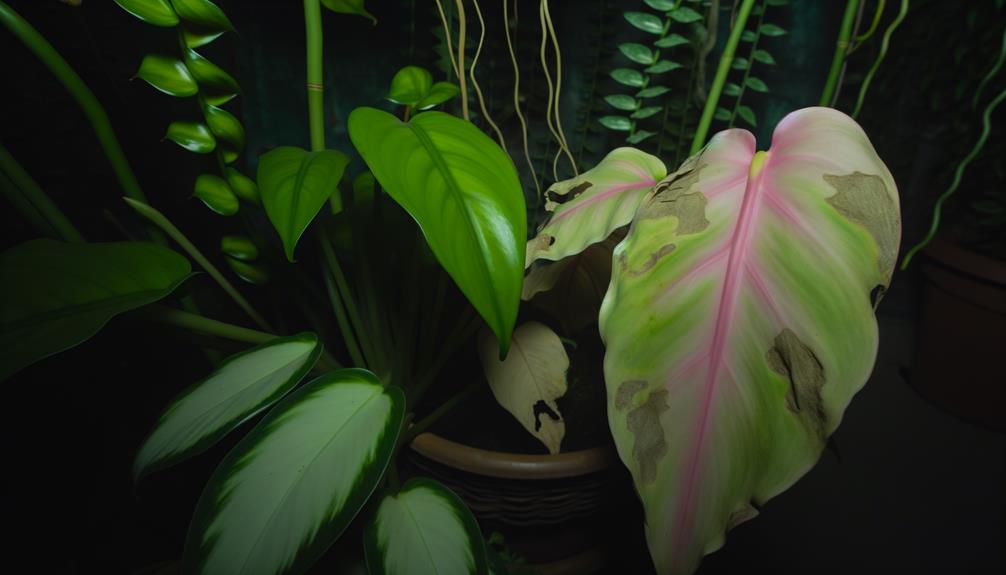
Nutrient deficiencies in Pink Princess Philodendrons often manifest as chlorosis, stunted growth, and poor leaf development, requiring a careful analysis of soil composition and fertilization practices. Key nutrients such as nitrogen, phosphorus, and potassium are essential for vibrant foliage and overall plant health.
Nitrogen deficiency typically presents as yellowing leaves, while phosphorus deficiency may cause dark, lackluster foliage and stunted growth. Potassium deficiency often results in marginal leaf burn and reduced variegation. Regularly applying a balanced, water-soluble fertilizer can alleviate these issues.
Moreover, ensuring micronutrients like iron and magnesium are present is vital for best chlorophyll production and leaf coloration. Monitoring and adjusting fertilization regimens based on observed symptoms can greatly enhance the plant's aesthetic appeal.
Soil Quality
Perfect soil quality is essential to the health and growth of Pink Princess Philodendrons, requiring a well-draining, aerated mix rich in organic matter. This guarantees root systems receive sufficient oxygen and nutrients, preventing waterlogged conditions that can lead to root rot and stunted growth.
Key components of an ideal soil mix include:
- Perlite: Improves aeration and drainage, avoiding compacted soil.
- Peat Moss: Holds moisture while maintaining a lightweight structure.
- Compost: Supplies essential nutrients and enhances organic content, promoting robust growth.
Observations indicate that inadequate soil quality disrupts nutrient uptake, negatively impacting the plant's variegation. Regularly checking and adjusting soil composition can alleviate these issues, ensuring the Pink Princess Philodendron remains vibrant and healthy.
Plant Age
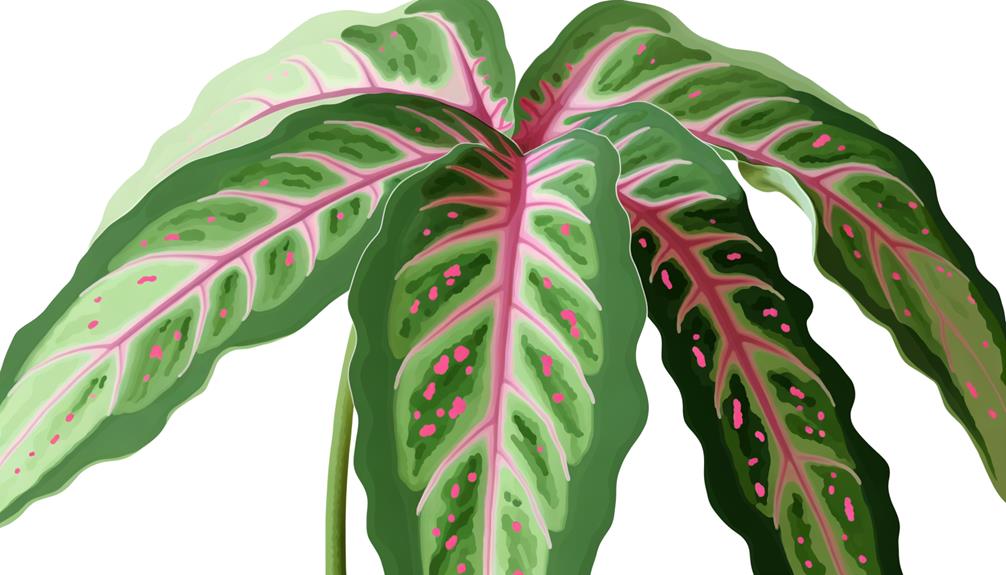
Understanding the age of a Pink Princess Philodendron is crucial, as it influences the plant's growth patterns, variegation stability, and overall health. Younger plants often exhibit less stable variegation, resulting in fewer pink leaves. As the plant matures, its ability to produce consistent variegation improves, often leading to more pronounced pink hues. Monitoring the plant's age allows for better expectations regarding variegation and overall aesthetic.
| Plant Age (Years) | Variegation Stability | Growth Patterns |
|---|---|---|
| 0-1 | Low | Rapid initial growth |
| 1-2 | Moderate | Slower, steady growth |
| 2-3 | High | Consistent development |
| 3-4 | Very High | Mature, robust growth |
| 4+ | Stable | Best health and size |
Careful observation and patience are key to achieving desired variegation.
Genetic Factors
Genetic factors play a pivotal role in determining the variegation patterns and overall health of the Pink Princess Philodendron. The plant's variegation is influenced by its genetic makeup, which dictates the distribution and intensity of the pink pigmentation.
Key genetic considerations include:
- Genetic Stability: Variegation can be unstable due to genetic mutations, leading to inconsistent pink coloration.
- Propagation Method: Plants propagated via cuttings from highly variegated parent plants tend to exhibit more pronounced variegation.
- Gene Expression: Environmental conditions can affect the expression of genes responsible for variegation, altering the pink-to-green ratio.
Understanding these genetic factors can help growers optimize conditions to maintain the desired aesthetic attributes of this unique plant species.
Pest Infestations
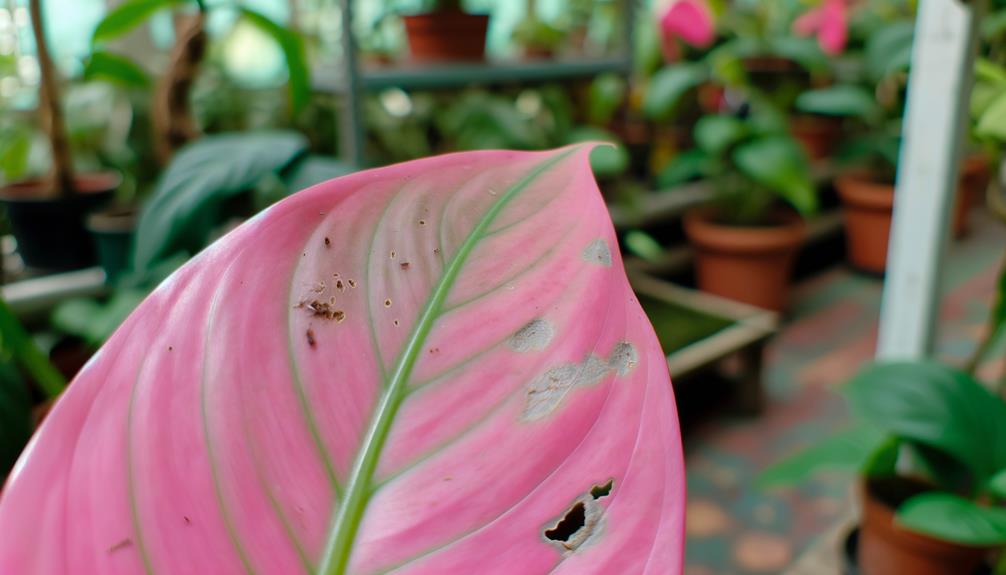
Pest infestations in Pink Princess Philodendrons are a significant concern, often showing through symptoms such as yellowing leaves, stunted growth, and visible insect presence. Common culprits include spider mites, aphids, and mealybugs. These pests feed on plant sap, depleting essential nutrients and causing chlorosis, or the yellowing of leaves due to insufficient chlorophyll.
Regularly examine the undersides of leaves and stems for small, moving insects or webbing. Immediate intervention is crucial; use insecticidal soap or neem oil as a biological control measure. For severe infestations, consider systemic insecticides.
Maintain optimal humidity and airflow to deter pests and regularly clean leaves with a damp cloth to remove dust and potential eggs. Regular monitoring guarantees early detection and effective management.
Conclusion
To sum up, the absence of pink coloration in a Pink Princess Philodendron can be linked to various factors such as inadequate or excessive light, incorrect watering, improper humidity levels, nutrient deficiencies, subpar soil quality, plant age, genetic diversity, and pest invasions.
Balancing these variables is like fine-tuning an orchestra; each component must work together to achieve the intended vibrancy.
Precise changes in care routines can revive the plant's distinctive pink shades, guaranteeing ideal growth and visual attractiveness.

